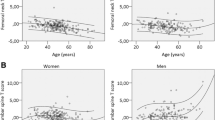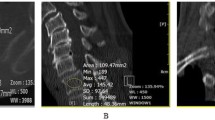Abstract.
Spinal cord injury (SCI), as well as other neuromuscular disorders, not only results in osteopenia but also induces various patterns of osseous, articular, and soft tissue alterations. In the spinal column, a variety of abnormalities occur. To evaluate the magnitude of discrepancy of bone densitometry results caused by spondylopathy in SCI patients, we analyzed anteroposterior (AP) radiographs of the lumbar spine [obtained within 1 month of dual energy X-ray absorptiometry (DXA)] in 116 SCI patients for various manifestations of spondylopathy, and matched the result to each vertebral level (L1, 2, 3, 4). The dataset was stratified by individual vertebra (totally 463 vertebrae) as valid (no demonstrable other abnormal density on plain radiograph except osteopenia), abnormal without, and abnormal with hardware. The influence of spondylopathy on bone densitometry results was determined by the analysis of variance (ANOVA) and post hoc analysis. Our results showed that 227 (49%) vertebrae were abnormal. Significant elevation (15%, 15%, 18%, 20%; P < 0.001–P < 0.05) of bone mineral density (BMD; g/cm2) was observed at all levels (L1, 2, 3, 4, respectively), particularly at those abnormal vertebrae without hardware compared with valid (no other abnormal density on radiograph except osteopenia (Table 1). The L4 level was most severely affected. We concluded that in SCI patients, owing to various secondary progressive skeletal abnormalities, particularly neuropathic spondylopathy, can have strongly and significantly elevated vertebral bone densitometry results, which can obscure underlying osteoporosis, leading to misinterpretation and underestimation of fracture risk. DXA, although characterized by improving spatial resolution, cannot replace radiography in establishing the magnitude of this skeletal pathology. Therefore, determination of bone density in this region with corresponding plain radiographs is highly recommended.
Similar content being viewed by others
Author information
Authors and Affiliations
Additional information
Received: 30 July 1996 / Accepted: 3 December 1996
Rights and permissions
About this article
Cite this article
Jaovisidha, S., Sartoris, D., Martin, E. et al. Influence of Spondylopathy on Bone Densitometry Using Dual Energy X-Ray Absorptiometry. Calcif Tissue Int 60, 424–429 (1997). https://doi.org/10.1007/s002239900257
Published:
Issue Date:
DOI: https://doi.org/10.1007/s002239900257




